Redesign and Evaluation of AffectiVest, a Wearable Tool to Convey Affection Gestures between Geographically-Separated Grandparents and Grandchildren †
Abstract
:1. Introduction
2. Related Work
3. Previous Work
3.1. Device Description
3.2. Preliminary Evaluation
4. Redesign of the AffectiVest Prototype
4.1. Redesign of the Architecture
4.2. Redesign of the Sender Application
4.3. Redesign of the AWC Device
4.3.1. Hugging Affective Gesture
4.3.2. Tickling in the Abdomen Affection Gesture
4.3.3. Tapping on the Shoulder Affection Gesture
4.3.4. Kissing Affection Gesture
5. Evaluation of the Redesigned AffectiVest
5.1. Participants
5.2. Procedure
6. Results and Discussion
6.1. Results of the Fidelity of Affection Gestures Questionnaire
6.2. Results of the SUS Questionnaire
6.3. Results of the TAM Questionnaire
7. Conclusions and Future Work
Author Contributions
Funding
Acknowledgments
Conflicts of Interest
References
- Wickramage, K.; Vearey, J.; Zwi, A.B.; Robinson, C.; Knipper, M. Migration and health: A global public health research priority. BMC Public Health 2018, 18, 987. [Google Scholar] [CrossRef] [PubMed]
- Kornhaber, A.; Woodward, K.L. Grandparents, Grandchildren: The Vital Connection; Transaction Publishers: New Brunswick, NJ, USA, 1981. [Google Scholar]
- Kornhaber, A. Contemporary Grandparenting; Sage: Thousand Oaks, CA, USA, 1996. [Google Scholar]
- Ross, N.; Hill, M.; Sweeting, H.; Cunningham-Burley, S. Grandparents and teen grandchildren: Exploring intergenerational relationships. Technical report, CRFR. 2005. [Google Scholar]
- Becker, O.A.; Steinbach, A. Relations between Grandparents and Grandchildren in the Context of the Family System. Comp. Popul. Stud. 2012, 37. [Google Scholar] [CrossRef]
- Ballagas, R.; Kaye, J.; Ames, M.; Go, J.; Raffle, H. Family communication: Phone conversations with children. In Proceedings of the 8th ACM International Conference on Interaction Design and Children, Como, Italy, 3–5 June 2009; pp. 321–324. [Google Scholar]
- Forghani, A.; Neustaedter, C.; Schiphorst, T. Investigating the communication patterns of distance-separated grandparents and grandchildren. In Proceedings of the CHI’13 ACM Extended Abstracts on Human Factors in Computing Systems, Paris, France, 27 April–2 May 2013; pp. 67–72. [Google Scholar]
- Picard, R.W.; Healey, J. Affective wearables. Pers. Technol. 1997, 1, 231–240. [Google Scholar] [CrossRef]
- Mueller, F.; Vetere, F.; Gibbs, M.R.; Kjeldskov, J.; Pedell, S.; Howard, S. Hug over a distance. In Proceedings of the CHI’05 Extended Abstracts on Human Factors in Computing Systems, Portland, OR, USA, 2–7 April 2005; pp. 1673–1676. [Google Scholar]
- Teh, J.K.; Tsai, Z.; Koh, J.T.; Cheok, A.D. Mobile implementation and user evaluation of the Huggy Pajama system. In Proceedings of the 2012 IEEE Haptics Symposium (HAPTICS), Vancouver, BC, Canada, 4–7 March 2012; pp. 471–478. [Google Scholar]
- Rosella, F.; Genz, R. Wearable Haptic Telecommunication Device and System. US Patent App. 11/515,690, 22 March 2007. [Google Scholar]
- Cabibihan, J.J.; Chauhan, S.S. Physiological responses to affective tele-touch during induced emotional stimuli. IEEE Trans. Affect. Comput. 2015, 8, 108–118. [Google Scholar] [CrossRef]
- Montañez, F.B.; Morán, A.L.; Meza-Kubo, V.; García-Canseco, E. Evaluation of an Affective Wearable Tool for the Transmission of Affection Gestures Between Geographically Separated Loved Ones. In Proceedings of the 2017 International Conference on Ubiquitous Computing and Ambient Intelligence (UCAMI), Philadelphia, PA, USA, 7–10 November 2017; pp. 808–813. [Google Scholar]
- Matute, E.; Rosselli, M.; Ardila, A.; Ostrosky-Solís, F. Evaluación Neuropsicológica Infantil; Manual Moderno: Ciudad de Mexico, Mexico, 2007. [Google Scholar]
- Yesavage, J.A.; Brink, T.L.; Rose, T.L.; Lum, O.; Huang, V.; Adey, M.; Leirer, V.O. Development and validation of a geriatric depression screening scale: A preliminary report. J. Psychiatr. Res. 1982, 17, 37–49. [Google Scholar] [CrossRef] [PubMed]
- Brooke, J. SUS-A quick and dirty usability scale. Usability Eval. Ind. 1996, 189, 4–7. [Google Scholar]
- Davis, F.D. Perceived usefulness, perceived ease of use, and user acceptance of information technology. MIS Q. 1989, 13, 319–340. [Google Scholar] [CrossRef]
- Bangor, A.; Kortum, P.T.; Miller, J.T. An empirical evaluation of the system usability scale. Int. J. Hum. Comput. Interact. 2008, 24, 574–594. [Google Scholar] [CrossRef]
- Sauro, J.; Lewis, J.R. Quantifying the User Experience: Practical Statistics for User Research; Morgan Kaufmann: San Francisco, CA, USA, 2016. [Google Scholar]
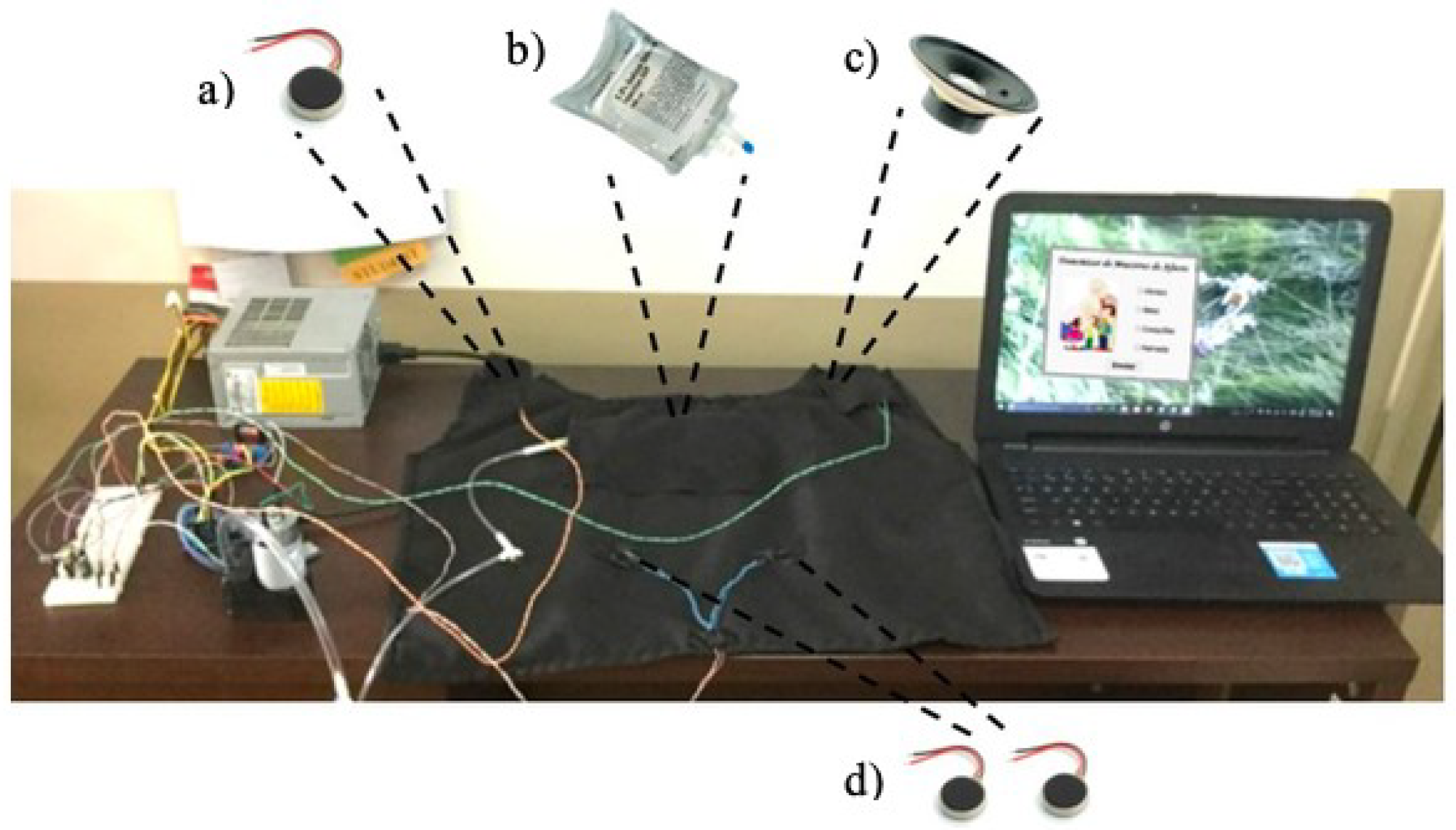
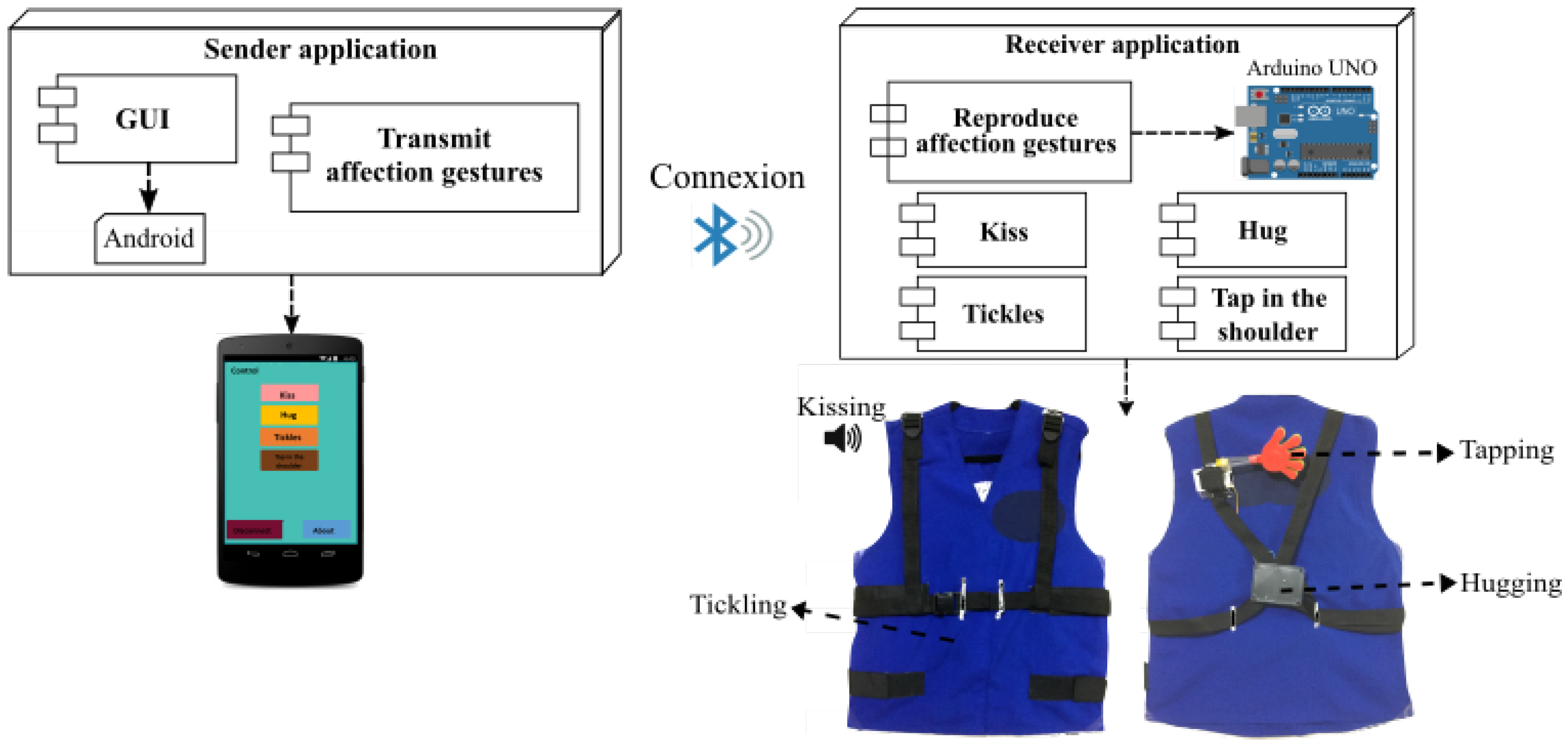


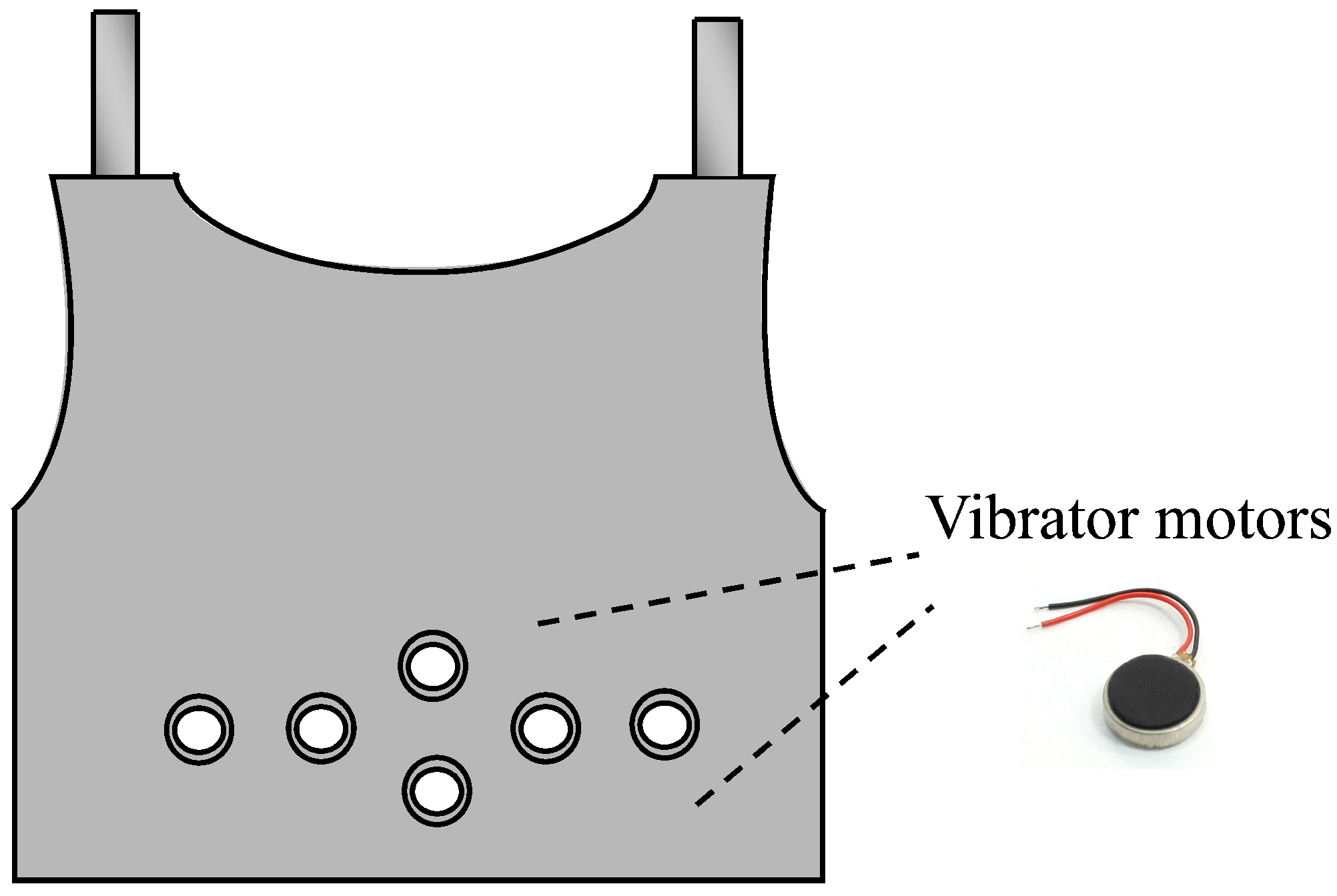
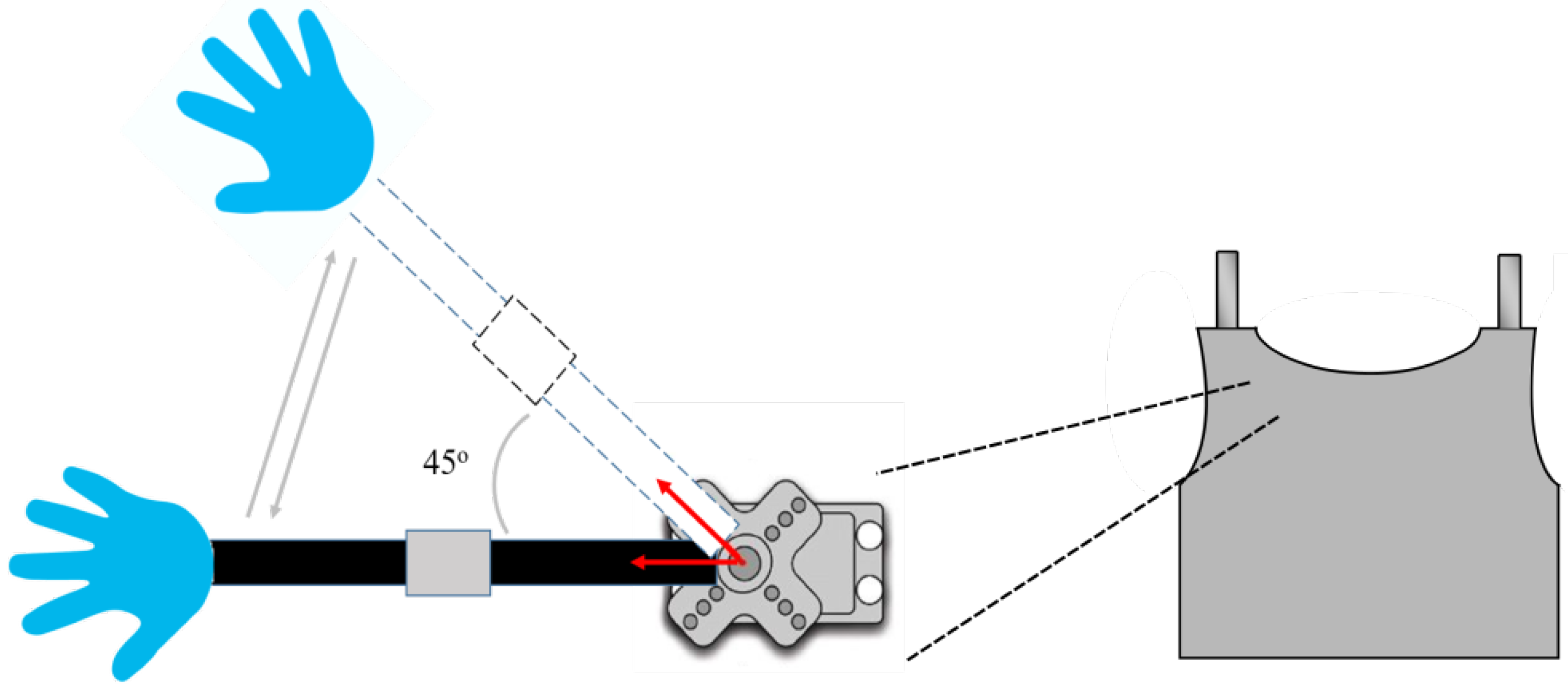


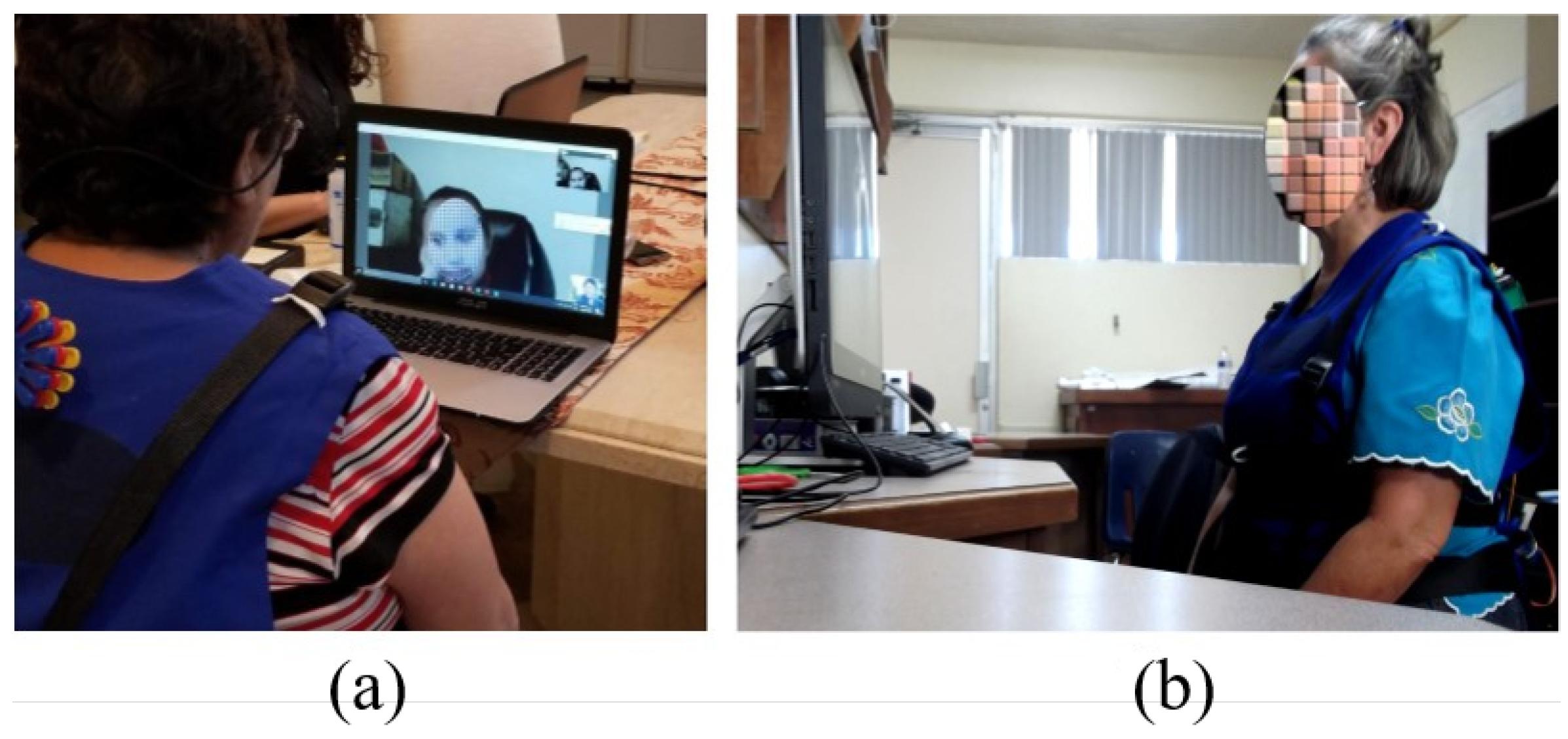


| Hugging | Kissing | Tickling on the Abdomen | Tapping on the Shoulder | |
|---|---|---|---|---|
| Unreal | 0% | 0% | 0% | 0% |
| Slightly real | 20% | 0% | 0% | 10% |
| Real enough | 35% | 30% | 10% | 5% |
| Real | 10% | 25% | 20% | 25% |
| Very real | 35% | 45% | 70% | 60% |
| Questions | ED | StD | SD | N | SA | StA | EA | Avg. | |
|---|---|---|---|---|---|---|---|---|---|
| 1. I will find AffectiVest useful to communicate with my grandparents/grandchildren. | 1 | - | - | - | 1 | 2 | 16 | 5.5 | |
| 2. Using AffectiVest for grandparent—grandchild communication would help strengthen our relationship. | - | 1 | - | 1 | - | 3 | 15 | 5.45 | |
| 3. Using AffectiVest for grandparent—grandchild communication would improve my mood. | - | - | 1 | 1 | - | 1 | 17 | 5.6 | |
| 4. Using AffectiVest for grandparent—grandchild communication would enrich our way of communicating. | - | 1 | - | - | 1 | - | 18 | 5.65 | |
| 5. Using AffectiVest for grandparent—grandchild communication would enable us to communicate more frequently. | - | - | 1 | 1 | - | - | 18 | 5.65 | |
| 6. Using AffectiVest for grandparent—grandchild communication would make our way of communicating more enjoyable and ease. | - | - | - | 1 | 1 | - | 18 | 5.75 | |
| Measures of central tendency and dispersion | |||||||||
| Mean | Median | Mode | Standard deviation | ||||||
| 5.6 | 6 | 6 | 1.12 | ||||||
| Extremely Disagree (ED), Strongly Disagree (StD), Slightly Disagree (SD), Neutral (N), Slightly Agree (SA), Strongly Agree (StA), Extremely Agree (EA) | |||||||||
| Questions | ED | StD | SD | N | SA | StA | EA | Avg. | |
|---|---|---|---|---|---|---|---|---|---|
| 7. I would find AffectiVest easy to use. | 1 | 1 | - | - | 1 | 1 | 16 | 5.3 | |
| 8. Learning to operate AffectiVest would be easy for me. | - | - | 1 | - | 1 | 2 | 16 | 5.6 | |
| 9. I would find it easy to get AffectiVest to do what I want it to do. | - | - | 2 | 1 | 1 | 3 | 13 | 5.2 | |
| 10. My interaction with AffectiVest would be clear and understandable. | - | - | 1 | - | - | 5 | 14 | 5.55 | |
| 11. I would find AffectiVest to be flexible to interact with. | - | - | 1 | - | - | 4 | 15 | 5.6 | |
| 12. It would be easy for me to become skillful at using AffectiVest. | - | - | - | 1 | 1 | 2 | 16 | 5.65 | |
| Measures of central tendency and dispersion | |||||||||
| Mean | Median | Mode | Standard deviation | ||||||
| 5.48 | 6 | 6 | 1.15 | ||||||
| Extremely Disagree (ED), Strongly Disagree (StD), Slightly Disagree (SD), Neutral (N), Slightly Agree (SA), Strongly Agree (StA), Extremely Agree (EA) | |||||||||
© 2019 by the authors. Licensee MDPI, Basel, Switzerland. This article is an open access article distributed under the terms and conditions of the Creative Commons Attribution (CC BY) license (http://creativecommons.org/licenses/by/4.0/).
Share and Cite
Montañez, F.B.; Meza-Kubo, V.; Ramírez-Fernández, C.; Morán, A.L. Redesign and Evaluation of AffectiVest, a Wearable Tool to Convey Affection Gestures between Geographically-Separated Grandparents and Grandchildren †. Proceedings 2019, 31, 66. https://doi.org/10.3390/proceedings2019031066
Montañez FB, Meza-Kubo V, Ramírez-Fernández C, Morán AL. Redesign and Evaluation of AffectiVest, a Wearable Tool to Convey Affection Gestures between Geographically-Separated Grandparents and Grandchildren †. Proceedings. 2019; 31(1):66. https://doi.org/10.3390/proceedings2019031066
Chicago/Turabian StyleMontañez, Flor B., Victoria Meza-Kubo, Cristina Ramírez-Fernández, and Alberto L. Morán. 2019. "Redesign and Evaluation of AffectiVest, a Wearable Tool to Convey Affection Gestures between Geographically-Separated Grandparents and Grandchildren †" Proceedings 31, no. 1: 66. https://doi.org/10.3390/proceedings2019031066
APA StyleMontañez, F. B., Meza-Kubo, V., Ramírez-Fernández, C., & Morán, A. L. (2019). Redesign and Evaluation of AffectiVest, a Wearable Tool to Convey Affection Gestures between Geographically-Separated Grandparents and Grandchildren †. Proceedings, 31(1), 66. https://doi.org/10.3390/proceedings2019031066





